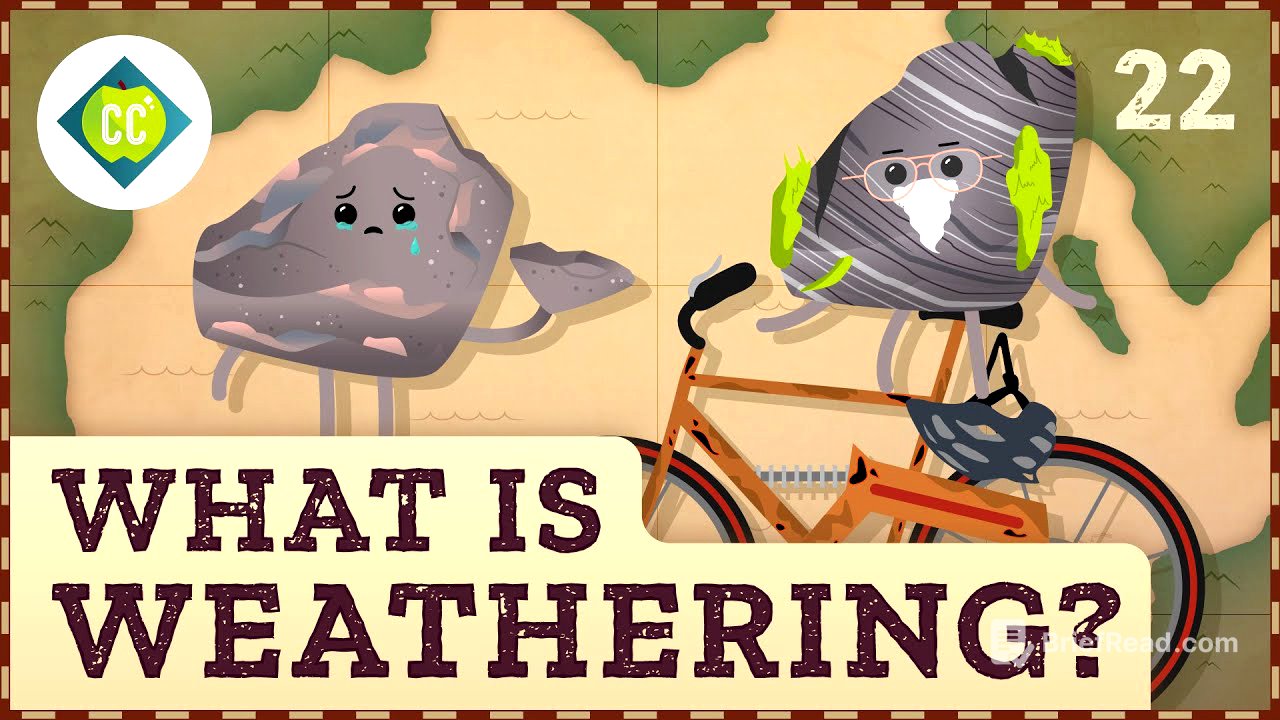TLDR;
This Crash Course Geography episode explains weathering, the process that breaks down rocks and shapes the Earth's surface. It covers the rock cycle, the relationship between weathering and erosion, and the three main types of weathering: mechanical, chemical, and biological. The video also explores karst topography, cave formation, and the impact of weathering on soil formation and global climate.
- Weathering is the breakdown of rocks into smaller pieces through mechanical, chemical, and biological processes.
- Erosion is the movement of weathered material by wind, water, ice, or gravity.
- Weathering is essential for soil formation and plays a role in shaping landscapes and influencing climate.
Introduction: Tectonic and Climate Systems [0:00]
The Earth's tectonic plates are constantly moving, leading to the formation of mountains, oceans, and various geological events. These tectonic activities are closely linked to climate systems, particularly through the process of weathering. Weathering involves the physical disintegration and chemical decomposition of rocks, which can remove carbon dioxide from the atmosphere and convert it into carbonates. The weathering of young mountains, such as the Himalayas, can significantly impact global climates.
The Rock Cycle and Weathering [1:27]
The Earth's topography is shaped by internal (endogenic) and external (exogenic) forces, driving the continuous creation and destruction of rocks and minerals in the rock cycle. Rocks formed under high temperatures and pressures deep within the Earth's crust decay when exposed to surface conditions. Weathering breaks down rocks into sediments, which are essential for soil formation and vegetation growth. Without weathering, the Earth's continental surface would be solid bedrock.
Weathering vs. Erosion and Types of Weathering [2:27]
Weathering prepares rock materials for movement, while erosion is the actual transport of these materials by wind, water, ice, or gravity. Together, they form the first stage of denudation, the wearing away of the landscape. Weathered rock can also move downhill due to gravity, known as mass movement, leading to mudslides and landslides. The three main types of weathering are mechanical, chemical, and biological.
Mechanical Weathering [3:20]
Mechanical weathering involves the physical breakdown of rocks into smaller fragments without altering their chemical composition. Frost action, where water expands upon freezing and breaks rocks, is a significant process in cold environments. Salt crystal growth in coastal and arid environments also contributes to mechanical weathering by exerting pressure within the rock. Mechanical weathering turns solid rock into regolith, the bottom layer of soil profiles, and increases surface area for other weathering processes.
Chemical Weathering [5:09]
Chemical weathering occurs when minerals in rocks are altered or decayed by agents like water, oxygen, and carbon dioxide. Oxidation, the combination of metallic elements with oxygen, weakens rocks, similar to rust forming on iron. Human activities, such as burning coal and oil, contribute to chemical weathering through the release of sulphur dioxide, which forms sulphuric acid and corrodes stone surfaces. Carbonation, the formation of carbonic acid, dissolves minerals and forms carbonates, especially in limestone, leading to karst topography.
Karst Topography and Cave Formation [6:54]
Karst topography is created by the dissolution of limestone through carbonation, resulting in disappearing streams, dry valleys, sinkholes, and caves. Solution caves form in limestone rock, often between limestone and shale layers. Caves are unique subterranean environments with fragile ecosystems, distinct climates, and formations like stalactites and stalagmites. Cave tourism can impact these environments, necessitating precautions to prevent the spread of diseases like white-nose syndrome in bats.
Biological Weathering and Conclusion [9:52]
Biological weathering involves the action of animals and plants, aiding both mechanical and chemical weathering. Tree roots can exert pressure on sidewalks, and organisms like bacteria, algae, fungi, and lichens can chemically alter minerals in rocks. Human activities, such as building quarries and agricultural practices, also significantly impact weathering processes. Weathering is a complex process that depends on various factors, including rock characteristics and climate conditions, and is interconnected with transport and erosion in shaping the Earth's surface.
